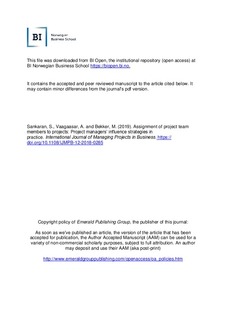Assignment of project team members to projects: Project managers’ influence strategies in practice
Journal article, Peer reviewed
Accepted version

View/
Date
2019Metadata
Show full item recordCollections
- Publikasjoner fra CRIStin - BI [1015]
- Scientific articles [2181]
Original version
10.1108/IJMPB-12-2018-0285Abstract
Purpose: The purpose of this paper is to investigate how project managers, influence the assignment of project team members by directly assigning or specifying who they want or by indirectly using lateral influence strategies to secure the appropriate resources. This study is part of a wider study investigating the balance between vertical and horizontal leadership in projects in which nomination (or assignment) was identified as a key event contributing to balancing the leadership. It focuses specifically on the nomination or assignment event at the start of a project. Design/methodology/approach: Based on the philosophy of critical realism, case studies were used to collect data through 70 semi-structured interviews in Australia, Scandinavia and South Africa. Interviews were conducted with senior managers, project managers and project team members. Two project team members who worked with the same project manager were interviewed to gather diverse views. The data were analyzed individually by researchers from each location using a coding method proposed by Miles et al. (2014). The researchers then jointly analyzed the findings to arrive at five common themes from that explained how team members were assigned in practice. Findings: Despite the recognized need for project managers to form their own teams, this study found that project team members were often assigned by others. This was because project managers lacked authority to secure their resources. Therefore, they used lateral influence strategies to help with assigning project team members. The study identified five lateral influencing strategies adopted by project managers to assign team members: creating an image of competence; creating coalitions; taking a gamble; waiting for the right moment; and reasoning with facts. Two of these lateral influencing strategies were not identified in the previous literature on influencing strategies used in organizations. Research limitations/implications: The findings should not be viewed as representative of the respective continents where the cases were studied. However, this study contributes to the literature on project management, illuminating how project teams are assigned and by whom and, specifically, the role that influence plays during this event of the balanced leadership theory. It also identifies the types of lateral influence strategies used by project managers when assigning team members to their projects. It provides a pathway to explore the use of lateral influencing strategies by project managers beyond the assignment process. Practical implications: This study will help project managers to become aware of influencing strategies that they can use in practice while assigning team members to their projects. It will also highlight the importance of assigning the right resources to projects with a view to achieving balanced leadership. Originality/value: This research is of value to organizations using projects to successfully deliver their strategies by assigning suitable resources to their projects.